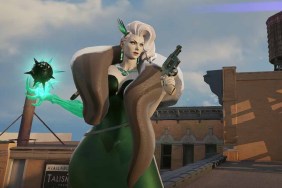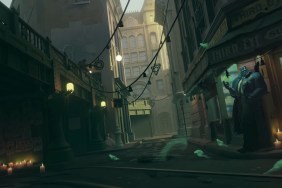No sign of decay.
Back
in
1998,
Metal
Gear
Solid
was
taking
over
the
Playstation
and
the
Nintendo
64
was
reveling
in
the
success
of
Ocarina
of
Time
(the
Sega
Saturn
was
sleeping
in,
or
something).
It
was
a great
time
to
own
a console,
but
the
PC
market
lacked
direction.
Nearly
every
release
seemed
to
be
just
another
version
of
an
earlier,
better
title;
witness
the
rash
of
real-time
strategy
games
patterned
almost
precisely
after
Command
& Conquer
and
Warcraft.
 The
The
biggest
news
came
from
the
multiplayer
front
as
the
success
of
Ultima
Online
and
the
subsequent
arrival
of
Everquest
signaled
a
shift
in
the
popular
game
design
paradigm.
Would
massively
multiplayer
gaming
be
the
Next
Big
Thing?
And
if
so,
would
everyone
jump
on
the
boat,
leaving
single-player
gaming
in
the
dust?
The answer came from an unlikely source, an upstart developer who had yet
to release their flagship title. That developer was Valve Software, and their
game, Half-Life, would
forever change the face of single-player PC gaming.
How good was the original Half-life? Good enough to earn over 50 Game
of the Year awards. Good enough to completely revolutionize first-person action.
Good enough to rewrite the definition of cinematic gameplay. It was so good
that it even spawned the most widely-played multiplayer game around, the beloved
Counterstrike
mod.
But it’s been many moons since we wrapped ourselves in the lab coat of Gordon
Freeman to do battle in the Black Mesa facility. So many other FPS’ have come
and gone that Half-life has almost fallen into myth.
Well,
it’s
time
for
another
coming
out
party,
because
if
the
final
version
of
Half-life
2
is
anything
like
the
30-minute
demo
I
enjoyed
at
E3
2003,
then
this
enormously
anticipated
sequel
will
make
its
older
brother
look
like
Pong.
You reprise your role as poor Gordon, who is now struggling to survive on
an Earth torn apart by the very hideous aliens he helped create and then kill
in the first place. But unlike his first romp through Black Mesa, Gordon must
now make his way through all manner of urban (and not so urban) environments,
a departure from the corridors, pipes and machinery of the first game.
The original Half-life engine powered more games than Duracell, but
now it clearly looks dated. The folks at Valve figured on this, and so have
spent the past four and a half years cooped up in their magic boxes working
on the brand new “Source” engine. And as a firsthand witness, I can testify
that all that hard work has paid off.
Big time.
Let’s start with the player models, which are now so eerily realistic that
you get a little creeped out when they stare at you. Forty facial muscles are
utilized to create a wide range of expressions, from the subtle raising of an
eyebrow to to the curving of a lip in disgust. This attention to detail also
leads to the most accurate lip-synching around. They even showed a character
speak the same line in English and Chinese with totally different synching.
the models is a physics system so lifelike that you really have to see it to
believe it. In-game objects react to force with stunning realism, particularly
as shown during the demo. Using an anti-gravity gun, Valve’s Managing Director
Gabe Newell flipped barrels into a pool of water, the heavier ones sinking,
the lighter ones bobbing on the surface. He then grabbed a mattress and tossed
it over a floating barrel, lending enough weight to make the object bob a little
deeper while the mattress flopped and conformed over the barrel as it should.
Taking
it
a
step
further
is
the
fact
that
surface
types
will
define
how
objects
react
to
the
environment.
Wood
chips
and
flakes
as
it
gets
shot,
while
nearly
unbreakable
metal
cans
slam
into
one
another
with
a
satisfying
clang.
Call it perfect hit detection or call it uncanny physics; I call it the kind
of graphical detail than could lead to countless gameplay enhancements. Imagine
fighting a giant enemy and hurling random debris at it to keep it at bay. Shoot
off the legs of a wooden platform and watch your ragdoll enemies slowly slide
into shimmering water. Lob a barrel at a gang of baddies and hope for a strike.
Bowling for carbine!
To demonstrate how the Source physics model could impact the gameplay, Newell
took us on a trip through one of the indoor/outdoor segments of the war-torn
City 17 locale. During one sequence, Gordon was attempting to make it up a staircase
under heavy fire from a baddie at the top. Again using the anti-grav gun, Gordon
yanked a radiator off the wall, used it as a shield from fire and then hurled
it at the enemy.
Another example of the synergy between physics and gameplay took place later
in the demo while Gordon was fleeing from an enemy airship. Running up a dirt
road littered with overturned cars, our hero found the wrecks to be the only
source of cover. However, the airship’s outrageous firepower created enough
force to literally push the cars backwards, skidding and grinding their way
back into Gordon. Narrowly escaping, Gordon then grabbed a rocket launcher and
took out the airship with a solid hit…only to watch in horror as the ship
crashed to the ground, roaring towards Gordon while smashing wrecked cars out
of the way, a runaway alien train. Sweet.
But Half-life wasn’t really about graphics – it was about fantastic
flow, cinematic scripting and great AI. Half-life 2 looks to up the ante
with enemies who actually TRY to kill you, even if you think you’ve outsmarted
them.
 One
One
example of this in the demo took place when Gordon ducked into a room to avoid
gunfire. He entered the room, shut the door and barricaded it by moving a desk
and several heavy objects to block entry. The enemy tried to get in, found the
door jammed and proceeded to break a window with his gun and shoot almost blindly
into the room, figuring he’d nail something.
This intellect goes for your allies as well. Lay down some cover fire and
they’ll move to a better position. They’ll duck and hide to avoid being shot,
slowly slinking their way forward rather than jumping out like Rambo to take
one in the mullet. Half-life 2 is not a squad-based game at all – you
do not directly control your allies – but the advanced AI almost makes it feel
like one.
There are still many unanswered questions surrounding the multiplayer setup and mod potential, but suffice to say that Valve understands the value of the fan community better than most developers. So far, it’s known that a map editor will ship with the game, but beyond acknowledging that there will be some sort of multiplayer, Valve and Vivendi have been tight-lipped.
As well they should be. It isn’t often you see a game with as much potential
as Half-life 2, and it’s ever rarer to feel entirely confident about
its final promise. But when you’re dealing with a track record like Valve’s,
it’s easy to see why so many jaded gaming journalists are clamoring to find
a cozy spot on the bandwagon. I’ve got mine, that’s for sure, and I’m not giving
up this front row seat until the game ships on September 30 of this year.
 |
 |
 |
 |












